- Company
- Products
- Technical report
- Indusrial cleaning
- Micro Joining and Assembly Technology
- Ultrasonic technology
- Trouble solution
- Cleaning
- Removing
- Attaching
- PCB Columns
Published on :
KAKEN TECH Co., Ltd. was established in 1966 and is now in its 56th year as an R&D-oriented chemical manufacturer. The company is headquartered in Katano City, Osaka, with two research centers in Shiga Prefecture, and about 40% of its employees belong to the Research and Development Department. (Fig.1)
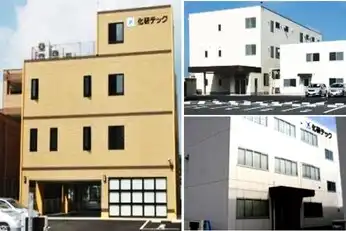
We mainly operate in the electronics, automotive/painting, and printing fields, and provides functional chemicals that solve the problems of customers in each field. In particular, in the flux cleaning business in the electronics field, we develop, design, and manufacture our own cleaning equipment as well as cleaning agents, and have the largest share of the domestic market as the only manufacturer that provides a total system of both the chemical solution and the equipment.
We have also been focusing on the development of conductive paste, which is attracting attention as an alternative to solder as a material to realize low-temperature bonding. We have established a technology to control the particle size of silver powder of various shapes (Fig. 2), and have commercialized many pastes with unique features such as high conductivity with low silver content.
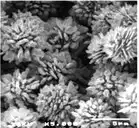
About 30 years ago, with the total abolition of CFC-113 and other specified CFCs, the cleaning of flux residue after soldering of electronic circuits, which had been dependent on CFC-based cleaning agents, reached a major turning point. While many manufacturers of cleaning liquid and equipment were moving toward semi-aqueous cleaning systems, only we, who had predicted the arrival of the age of high-frequency, high-speed communications at the time, was alerted to the many problems associated with the water rinse method. This led to the development and commercialization of a unique cleaning system using a water-containing alcohol rinse liquid, "MARKLESS® ST-05" (hereinafter referred to as ST-05), which does not cause dielectric loss.
The biggest problem with the water rinse method is that it produces a large amount of wastewater due to the pouring of pure water. (Fig.3)
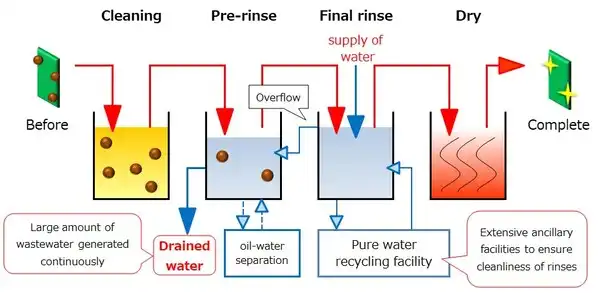
On the other hand, our cleaning system "MICROCLEANER®", which uses ST-05U as a rinse liquid, has a built-in small distiller that enables stable distillation and regeneration without changing the composition of ST-05U, which is a non-azeotropic mixed liquid containing hydrous alcohol. As shown in Fig. 4, the dirty liquid in the pre-rinse tank becomes clean distillate through distillation and flows to the final rinse tank, leaving the dirt concentrated in the distiller. When the liquid level in the final rinse tank reaches a certain level due to the supply of distillate, it overflows into the pre-rinse tank. Through this repetition, the ST-05U is completely recycled in closed system, and can continue to maintain a high level of cleanliness. The amount of waste liquid is much less than that of the water rinse method because only the liquid in the distiller, which contains highly concentrated flux residue and contaminants such as detergent components, becomes waste liquid.
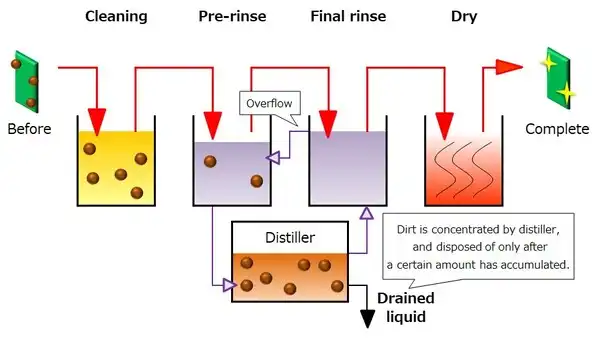
In addition, when ST-05U is used as a rinse liquid, there is no need to add surfactants to the cleaning liquid to ensure rinse ability, as is the case with semi-aqueous cleaning systems, and there is no risk of increased dielectric loss due to hydrophilization of the electronic circuit surface. In addition, since hydrous alcohol has high disinfecting power, as is widely known in countermeasures against new coronavirus infection, ST-05U eliminates the need for countermeasures against microbial contamination, which is important in water rinsing.
The ST-05U rinse system has become the mainstream flux cleaning system in Japan, along with semi-aqueous systems, due to the popularity of these features at many customers' manufacturing sites. Recently, the MICROCLEANER ® won two awards at the 15th (2021) Vision Awards held by SMT China Surface Mount Technology in China. (Fig. 5)
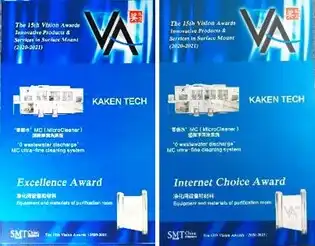
Even now, in the 5G era, when higher cleaning quality is required, it is recognized as an effective cleaning system, and our cleaning system that draws on the features of ST-05U, a hydrous alcohol-based rinse liquid, is still steadily increasing its market performance.
On the other hand, the low volatile organic solvent (VOC) emissions and the high safety of water itself are the reasons behind the persistent use of semi-aqueous cleaning systems today.
As environmental problems have become more serious in recent years, flux cleaners are required to be designed in an environmentally friendly manner. In particular, reducing environmental emissions of VOCs, which are the main cause of air pollutants such as suspended particulate matter (SPM) and photochemical oxidants, is a major keyword.。
Since ST-05 contains alcohol, it emits more VOCs than water and has a flash point (like alcoholic beverages, it has a flash point but is not classified as a hazardous material under the Fire Service Law), so semi-aqueous cleaning systems have an advantage in these respects.
In response to this situation, we have developed a new environmentally friendly high-performance cleaning liquid, MICROCLEAN ECO-8100U (hereinafter referred to as ECO-8100U), and a new rinse liquid, MARKLESS® ECO-R81U (hereinafter referred to as ECO-R81U), which have evolved by solving the shortcomings of the ST-05U rinse system based on our accumulated cleaning liquid design technology and cleaning process development technology and will introduce in this paper.
ECO-8100U/ECO-R81U are both composed of about 70% water, which means that the total amount of VOC emissions due to volatilization and drying can be reduced to about half while maintaining the same level of cleaning quality as the conventional ST-05U rinse system.
Both the cleaning and rinse liquid are in the neutral pH range, and although they contain a lot of water, they do not affect the main metal materials that make up electronic circuits, such as copper and aluminum. In addition, it does not swell or deform resin materials in general, such as epoxy resin, Teflon, polyimide, and polyvinyl chloride, which are used in substrates and cleaning equipment.
Both ECO-8100U and ECO-R81U have no flash point, are non-hazardous materials under the Fire Service Law, and do not fall under the Poisonous and Deleterious Substances Control Law, the Law Concerning Reporting, etc. of Releases to the Environment of Specific Chemical Substances (PRTR Law), or any other related laws and regulations. (Table 1)
| Product Name | Cleaning liquid MICROCLEAN ECO-8100U |
Rinse liquid MARKLESS® ECO-R81U |
|---|---|---|
| Main component | Glycol ether-based | Glycol ether-based |
| Specific gravity (20℃) | 0.98 | 0.98 |
| Viscosity mPa・S (20℃) |
4.0 | 2.7 |
| Surface tension mN/m (20℃) |
32 | 31 |
| Boiling point ℃ | >100 | >100 |
| Flash point ℃ | None | None |
| Ozone Depletion Potential (ODP) |
0 | 0 |
| Hazardous materials in Fire Service Law |
Not applicable | Not applicable |
| Ordinance on Prevention of Organic Solvent Poisoning |
Not applicable | Not applicable |
| PRTR law | Not applicable | Not applicable |
| VOCs defined by the Ministry of the Environment |
Not applicable | Not applicable |
In addition, ECO-8100U and ECO-R81U are semi-aqueous detergents under the compulsory national standard (GB standard) for limiting VOC content in detergents, which came into effect in China in December 2020, and can be used in China without any problem.
Since ECO-8100U and ECO-R81U share the same main component, unlike conventional semi-aqueous cleaning systems, the cleaning and rinse liquid can be compatible without limitation. This design ensures good liquid displacement even in narrow gap under components.
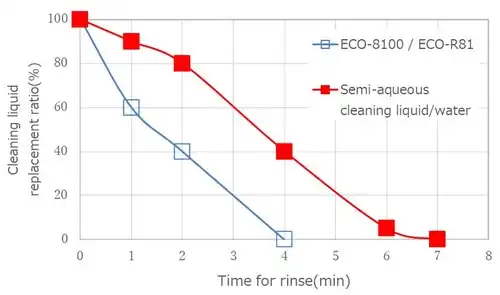
Fig. 6 shows the results of the comparative evaluation of the liquid displacement rate using narrow gap samples with an average of 15 µm. After penetrating ECO-8100U and semi-aqueous detergent colored with dye under the gap, each was rinsed with the corresponding rinse liquid under the same conditions, and the time until the cleaning liquid was completely replaced and discharged was measured. The time required to complete the rinse process was about 7 minutes for the semi-aqueous detergent/water rinse system, while it was about 4 minutes for the ECO-8100U/ECO-R81U system, a reduction of almost half.
The rinse liquid, ECO-R81U, is a non-azeotropic formulation, but the flow shown in Fig. 4 using our distiller allows to maintain cleanliness without compositional changes same as in ST-05.
In the ST-05 rinse system, the cleaning liquid component brought into the rinse liquid is also removed as dirt by distillation and regeneration, but in the case of ECO-8100U/ECO-R81U, since more than 90% of the components are common, most of the ECO-8100U brought into ECO-R81U is reused as rinse liquid. As a result, the amount of waste liquid generated can be reduced by about 85% from the conventional ST-05 rinse system. (Fig. 7)
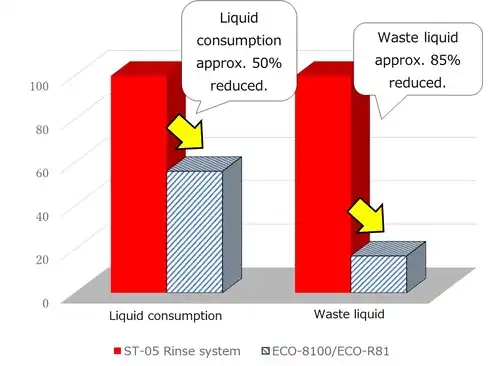
ECO-8100U has a special phase structure in which an invisible micron-sized oil phase is dispersed in the aqueous phase, and despite the fact that it contains a large amount of water (70-80 wt%), its dissolving power surpasses that of flux cleaners with little or no water in the market. In addition, this phase structure was found to be highly effective in removing various types of particles on the cleaned materials. The details are described in the next section.
It also has a high removal capacity for copper oxide films, while not corroding the solid copper surface.
When designing low-VOC cleaning liquid, if the active ingredients are simply diluted in water, the strong interaction (hydration) between water molecules and the polar sites of the active ingredients will inhibit the reaction between the dirt and the active ingredients, resulting in a significant decrease in flux dissolution and cleaning power. In the low-VOC flux cleaner MICROCLEAN ECO-3002U ((hereinafter referred to as ECO-3002U), which we quickly solved this problem and commercialized, the water and solvent components are separated into two phases, and the independent solvent phase (oil phase) is dispersed in the water phase in a white emulsion state.1)
In response to the emergence of many similar products that seemed to be based on this technology, we further developed and established a new technology that is far different from those of our competitors. This is the "micro-phase separation structure". (Fig. 8)
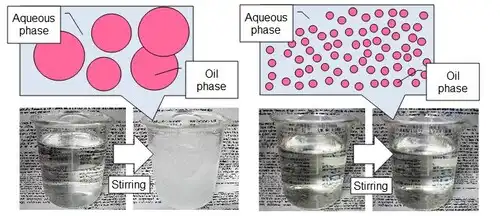
The ECO-8100U has a stable phase structure with countless micron-sized oil phases dispersed in water, which are invisible to the naked eye, enabling it to maintain a uniform transparency in appearance while demonstrating high flux cleaning performance. (Patent pending)
Fig. 9 shows a photograph of the appearance of ECO-8100U compared to a non-separable type of high water content cleaning liquid consisting of glycol ether, water, and cleaning aid, as well as a glycol ether-based cleaning agent and its flux dissolving power. 3 wt% of rosin flux residues were added to each cleaning liquid, dissolved and dispersed by ultrasonic irradiation, and then left to stand at a liquid temperature of 25°C to check its appearance. In the case of the high water content cleaning liquid that does not have a phase separation structure, the main resin component in the flux residue is not fully dissolved in the liquid and is ejected, resulting in suspension and precipitation (Fig. 9, right), whereas ECO-8100U (left) maintains a uniform transparent state without suspension just like the glycol ether cleaning liquid (center) and the difference in solubility is obvious.
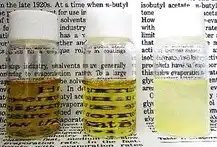
The existence of this micro-phase separation structure and the high compatibility between ECO-8100U and ECO-R81U make it possible to clean narrow gaps of less than 15 µm, such as under package components, more effectively than with conventional cleaning systems.
The cleaning agent that penetrates underneath the components becomes thickened due to the dissolution of flux, preventing it from being discharged from underneath the component and replaced by a cleaning liquid with a lower dirt concentration, and cleaning usually becomes more difficult as the gap becomes narrower and the amount of flux increases. Also, in semi-aqueous cleaning systems, because of the limited compatibility between the cleaning liquid and water, it takes time for the water to penetrate and displace under the components filled with the cleaning liquid. On the other hand, in the case of ECO-8100U, most of the rosin and other non-polar resin components that causes thickening are dissolved in the oil phase, but the structure of the oil phase finely dispersed in the water phase makes it difficult for the cleaning liquid as a whole to cause thickening. (Fig. 10)
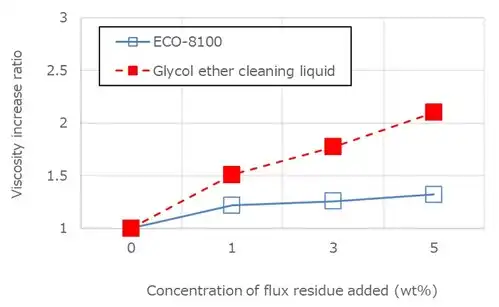
Furthermore, since ECO-8100U and ECO-R81U share the same main component, not only can good rinsing be ensured in a short time even under narrow gaps, but also the flux component will not be discharged or re-deposited on the material to be cleaned, no matter how much dirty ECO-8100U is brought into ECO-R81U. Therefore, it is possible to maintain a stable cleaning quality. (Fig. 11)
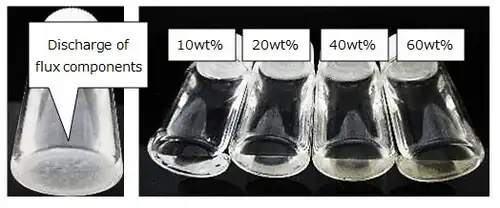
It has also been found that the presence of numerous fine hydrophobic regions in the aqueous phase due to the microphase separation structure is effective in removing all types of particles. Fig. 12 shows the cleaning mechanism of the ECO-8100U for organic particles (sebum + skin fragments) originating from the human body, which are particularly difficult to remove among particles.
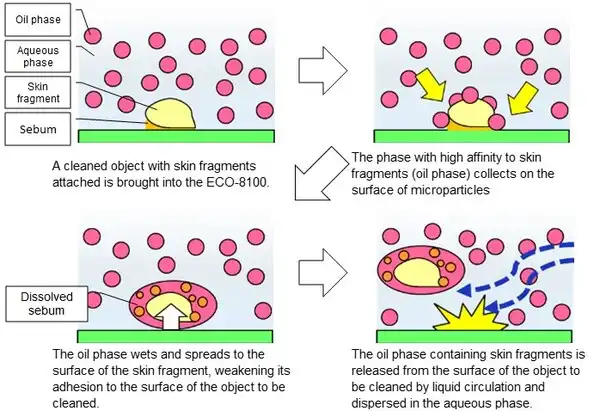
One phase with higher affinity (mainly the oil phase) wets and spreads over the surface of the particles, thereby weakening the interaction and physical adhesion between the surface to be cleaned and the particles. It is assumed that the other phase (mainly aqueous) has the effect of pulling the particle-containing oil phase away from the surface to be cleaned and dispersing it.
Recently, in the manufacturing process of electronic products such as HDDs, camera modules, CPU package substrates, etc., where even a small amount of residual foreign matter can affect performance, a cleaning process that simultaneously removes not only flux but also micron-order particles are of particular importance. Although ultrasonic cleaning is widely used as a method of particle removal, it is difficult to clean particles consisting of an unspecified number of organic and inorganic substances without optimal formulation design from the cleaning agent side as well.
As an example, Table 2 shows the results of comparative evaluations of the removal of organic and inorganic particles using ECO-8100U/ECO-R81U, a conventional semi-aqueous cleaning system, and water. As a test piece for evaluating the removal of organic particles, a piece of sebum/skin of a test person was adhered on a glass plate and dried at 90°C for 3 hours. For the inorganic specimens, alumina particles (particle size: 3.7µm), which are commonly used as abrasives, were dispersed in an organic solvent, dropped onto a glass plate, and dried.
| Object to be cleaned | ECO-8100U/ECO-R81U | Semi-aqueous cleaning liquid/water | Water | |||
|---|---|---|---|---|---|---|
| Stirring | Ultrasonic | Stirring | Ultrasonic | Stirring | Ultrasonic | |
| Sebum + skin fragments | 〇' | ◎ | △ | ◎ | × | × |
| Alumina particles | 〇 | ◎ | × | 〇 | × | 〇' |
[Evaluation criteria] ◎:100% / 〇:99~90% / 〇':89~70% / △:69~40% / ×:39% or below
[Cleaning conditions] Stirring:500rpm for 1min at room temp., Ultrasonic:28kHz(100W) for 1min at room temp.
| Appearance after cleaning of sebum + skin fragment sample | Appearance of alumina particle sample after cleaning | ||
|---|---|---|---|
| ECO-8100U After ultrasonic cleaning |
水 After ultrasonic cleaning |
ECO-8100U After ultrasonic cleaning |
水 After ultrasonic cleaning |
 |
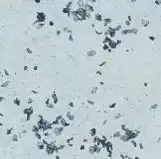 |
 |
 |
ECO-8100U/ECO-R81U showed higher removal rates of sebum, skin debris, and alumina particles than any other detergents even under agitation-only cleaning conditions due to the contribution of microphase separation structure, and complete removal was possible when combined with ultrasonic.
As described above, the ECO-8100U/ECO-R81U is a next-generation cleaning system that responds to the high hurdle of cleaning flux residue and particles simultaneously, as well as ensuring narrow gap cleaning.
ECO-8100U/ECO-R81U can be applied to electronic components and materials in general without any particular restrictions because it has little effect on resin and metal components used in substrates. In addition, because of its excellent solubility in metal salts and resin components, it has sufficient cleaning power for water-soluble fluxes and fluxes for lead-free soldering.
The ECO-8100U/ECO-R81U is designed to be used with our flux cleaning system, MICROCLEANER®, which has been proven in the market for many years. We are capable of proposing and manufacturing the most suitable equipment according to the customer's work and production conditions, installation space, and detailed requirements, including the cleaning method, distiller capacity, size of the tank, and whether or not an automatic conveyer system is necessary. (Fig. 13)
For customers who have already installed the MICROCLEANER®, the ECO-8100U/ECO-R81U can be used as is (some parts may need to be replaced depending on specifications).
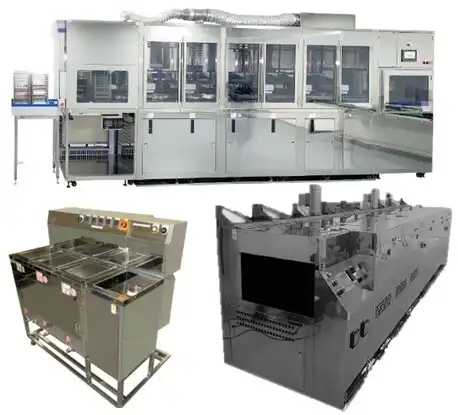
Both ECO-8100U and ECO-R81U have no flash point, and there are few other factors that limit the properties of the liquid, so they can be used with any cleaning method, including jet, ultrasonic, and shower cleaning methods, without any problems.
The ECO-8100U/ECO-R81U is already gaining a growing track record at many customer sites, including those overseas.
As we enter the 5G era, there is a need for a cleaning liquid and process that can simultaneously meet the trade-offs of higher cleaning quality and compatibility with a wide variety of cleaning objects beyond the scope of flux cleaning, and restrictions on formulation design due to stricter global regulations on chemical substances.
We are proud to say that the ECO-8100U/ECO-R81U introduced here is an epoch-making product that can be said to be the best solution to the severe requirements surrounding flux cleaning.
In the electronics industry, which continues to make rapid progress, we have always been one of the first to identify industry trends and develop products to provide the best cleaning quality for each of our customers' products. We will not be satisfied with the current situation, but will continue our research and development ahead of the times to contribute to the field of manufacturing.
【Source】
Industrial Cleaning, November 10, 2021, No. 28 (Japan Industrial Conference on Cleaning)
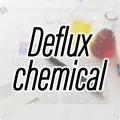 |
Technial report
|
|---|---|
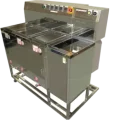 |
Products information
|
KAKEN TECH, MICROCLEANER, MICROCLEAN&MARKLESS and MARKLESS are trademarks of KAKEN TECH CO., LTD. in PRC.
KAKEN TECH is a trademark of KAKEN TECH CO., LTD. in the U.S..
| Inquiry |